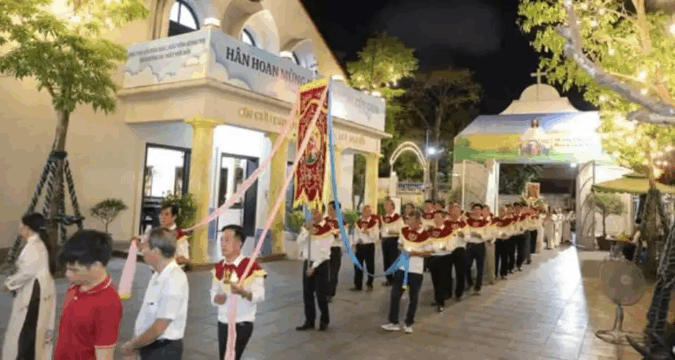
Alex Hoang
Vietnam has fewer than seven million Catholics, yet nearly four million live away from their home parishes. Most are young workers, students, and migrants who have moved from rural dioceses such as Bui Chu, Phat Diem, Thai Binh, or Vinh to large cities like Ho Chi Minh City, Hanoi, or Binh Duong.
This internal migration—one of the largest in Southeast Asia—has become a major pastoral challenge for the Vietnamese Church. In factories and rented rooms, faith often fades under the pressure of work, exhaustion, and isolation.
Reality of scattered flock
Every Sunday evening in Binh Duong Province, Vietnam’s industrial heartland, the streets near Song Than Industrial Park remain bright under the glow of factory lights. Inside a small boarding room barely nine square metres wide, Hanh, a 25-year-old garment worker from Nam Dinh Province, ties her hair and whispers a short prayer before heading out for her night shift.
“Back home, I used to pray with my family after dinner,” she says. “Now I work nights, even on weekends, so I often pray alone before leaving for the factory.”
For Hanh, Sunday is just another workday. Her company, like thousands of factories in southern Vietnam, runs around the clock to meet export orders. The long shifts leave little time for rest—or for attending Mass.
In factories and rented rooms, faith often fades under the pressure of work, exhaustion, and isolation
According to Father Nguyen Ngoc Nga, head of the migrant ministry of the Archdiocese of Ho Chi Minh, many young Catholics far from home lose contact with parish life and need stronger accompaniment to reconnect with their faith.
According to some stories published on Catholic websites, at Thach Da parish, which serves thousands of migrant workers, priests recall how some break down in tears before the statue of Our Lady, longing for home.
“Many can’t afford to go home for Tet, so the parish celebrates the New Year with them here,” said the parish priest.
Living far from their parishes also means many Catholic families neglect catechism and faith education. Their children grow up with little religious instruction, creating a generation that still identifies as Catholic but seldom practices its faith.
The Church now faces a double mission: to re-evangelise its own people while continuing to evangelise those who don’t know the faith.
Now I work nights, even on weekends, so I often pray alone before leaving for the factory
Hanh
How the Church is responding
To address this, the Vietnamese Church has made migrant ministry a pastoral priority. Over the past decade, dioceses and religious congregations have founded numerous “migrant communities”—informal parishes for people from the same hometown or diocese.
One of the most active examples is the Thai Ha Migrant Community in Hanoi, run by the Redemptorists. Each month, thousands from provinces such as Vinh, Thanh Hoa, and Bui Chu gather for Mass, choir practice, catechism, and charitable work.
Redemptorist Father Peter Nguyen Van Phuc, said migrants are considered full members of the parish community, and that their presence brings new vitality to the Church.
In the Archdiocese of Ho Chi Minh and nearby dioceses like Xuan Loc and Phu Cuong, priests have been appointed specifically to serve migrants. Some parishes offer boarding houses for female workers and organise catechism classes, life-skill workshops, and “homecoming festivals” for those far from home.
Yet challenges remain. The Church lacks enough priests and pastoral workers to serve such a vast population. Many migrant groups dissolve after a few months because of unstable jobs or a lack of space for gatherings
Living far from their parishes also means many Catholic families neglect catechism and faith education. Their children grow up with little religious instruction, creating a generation that still identifies as Catholic but seldom practices its faith
Administrative issues—such as marriage preparation or baptism certificates—are also difficult to manage. For factory workers on rotating shifts, attending Sunday Mass regularly remains a distant hope.
Lessons from abroad
Vietnam is not alone in facing this challenge. The Church in the Philippines has a National Commission for Migrants, sending chaplains to accompany overseas workers in the Middle East, Korea, and Europe.
In South Korea, dioceses have opened multilingual pastoral centres where Mass is celebrated in Vietnamese, Tagalog, and Indonesian. Across Europe and the United States, Vietnamese Catholic communities are led by native priests, preserving both faith and culture abroad.
Compared with these models, Vietnam’s approach is more localised—smaller in scale but deeply community-based. Rather than building national structures, the Church relies on parish-level creativity and the dedication of priests, religious, and lay volunteers who reach out to migrants where they live.
As Father Nguyen has noted, migrants have not abandoned God; they are simply searching for a way to live their faith amid the struggle to survive
A Church that walks with its people
Migration is reshaping not only the country’s economy but also the face of Vietnamese Catholicism. Rural parishes grow old and quiet, while urban churches overflow every Sunday with young faces far from home.
In this shift, the Church is learning to become “a Church on the move”—one that goes beyond parish walls to meet people in factories, dormitories, and rented rooms.
As Father Nguyen has noted, migrants have not abandoned God; they are simply searching for a way to live their faith amid the struggle to survive.
In that struggle, faith continues to flicker. In a nine-square-metre room shared by two workers, a small crucifix hangs on the wall. Someone whispers a prayer before sleeping.
It may be far from home, but for Vietnam’s Catholic migrants, it is still a sacred space—a small church of their own.










